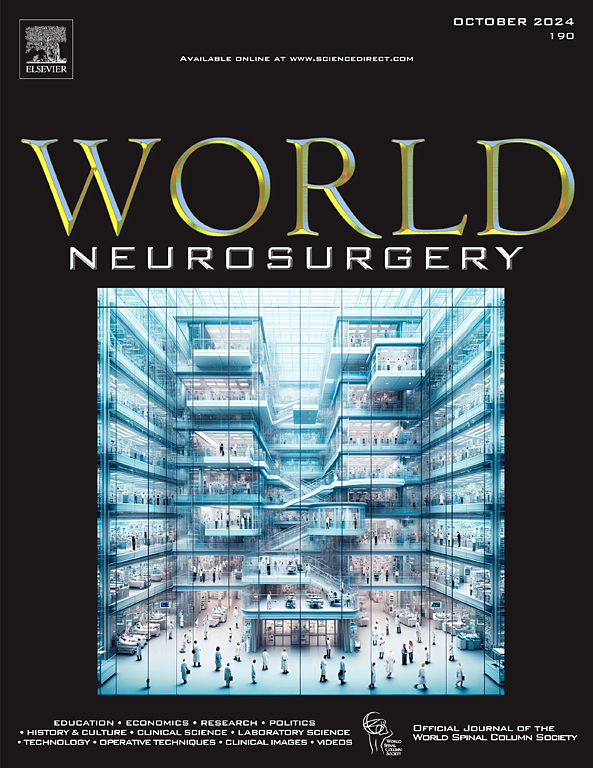The Effect of Body Mass Index on Surgical Outcomes Following Aseptic Short-Segment Revision Lumbar Fusions: A Retrospective Study
IF 1.9
4区 医学
Q3 CLINICAL NEUROLOGY
引用次数: 0
Abstract
Background
This study investigated the association among preoperative body mass index (BMI) and surgical outcomes, reoperation rate, and 1-year patient-reported outcome measures (PROMs) following 1–3 level revision lumbar fusion.
Methods
Patients who underwent a 1–3 level revision lumbar fusion from 2011–2021 were included. Patients were grouped into BMI classes: normal (18.5–24.99), overweight (25.0–29.99), obese class 1 (30.0–34.99), and obese class 2+ (≥35.0). Demographics, surgical characteristics, 1-year reoperations, 90-day readmissions, and 1-year PROMs were compared between cohorts. PROMs included the Short Form-12 Physical Component Score, Mental Component Score, Oswestry Disability Index, Visual Analog Scale Back pain score, and Visual Analog Scale Leg pain score.
Results
In total, 743 patients were identified: 115 normal weight, 254 overweight, 206 obese class 1, and 168 obese class 2+. Operative time (P = 0.007) and length of stay (LOS) (P = 0.002) were longer in patients with higher BMI. Multivariate regression demonstrated obese class 2+ was independently associated with longer operative times (estimate: 32.43; P = 0.008) and LOS (estimate: 0.68; P = 0.044). There were no differences in readmission (P = 0.285) or reoperation rates (P = 0.727). All patients received a similar benefit between preoperative and 1-year PROMs.
Conclusions
While more obese revision lumbar fusion patients experienced longer operative times and LOS, these patients ultimately experienced similar improvements from surgical intervention at 1 year postoperatively. Regardless of BMI class, all patients had comparable rates of readmission within 90 days and reoperation. These findings support previous lumbar fusion literature and suggest an indicated revision lumbar fusion in higher BMI class patients does not lead to further reoperations or worse PROMs.
体重指数对无菌短节段腰椎融合术后手术结果的影响:一项回顾性研究。
目的:本研究探讨术前体重指数与1-3节段腰椎融合术后手术结果、再手术率和1年患者报告的预后指标(PROMs)之间的关系。方法:纳入2011-2021年接受1-3节段腰椎融合术翻修的患者。BMI分为正常(18.5 ~ 24.99)、超重(25.0 ~ 29.99)、肥胖1级(30.0 ~ 34.99)、肥胖2+级(≥35.0)。比较两组患者的人口统计学、手术特征、1年再手术、90天再入院和1年prom。PROMs包括短表-12身体成分评分、精神成分评分、Oswestry残疾指数、视觉模拟量表(VAS)背痛评分和VAS腿部疼痛评分。结果:共确定743例患者,其中体重正常115例,超重254例,1级肥胖206例,2+级肥胖168例。BMI高的患者手术时间(p=0.007)和住院时间(LOS) (p=0.002)更长。多因素回归显示肥胖2+级与较长的手术时间独立相关(估计:32.43;p=0.008)和LOS(估计:0.68;p = 0.044)。两组再入院率(p=0.285)和再手术率(p=0.727)差异无统计学意义。所有患者在术前和1年PROMs期间均获得相似的获益。结论:虽然更多的肥胖翻修腰椎融合患者经历了更长的手术时间和更长的LOS,但这些患者最终在术后1年的手术干预中获得了类似的改善。无论BMI等级如何,所有患者在90天内的再入院率和再手术率相当。这些发现支持了之前的腰椎融合术文献,并表明对高BMI级别患者进行指向性翻修腰椎融合术不会导致进一步的再手术或更严重的PROMs。
本文章由计算机程序翻译,如有差异,请以英文原文为准。
求助全文
约1分钟内获得全文
求助全文
来源期刊

World neurosurgery
CLINICAL NEUROLOGY-SURGERY
CiteScore
3.90
自引率
15.00%
发文量
1765
审稿时长
47 days
期刊介绍:
World Neurosurgery has an open access mirror journal World Neurosurgery: X, sharing the same aims and scope, editorial team, submission system and rigorous peer review.
The journal''s mission is to:
-To provide a first-class international forum and a 2-way conduit for dialogue that is relevant to neurosurgeons and providers who care for neurosurgery patients. The categories of the exchanged information include clinical and basic science, as well as global information that provide social, political, educational, economic, cultural or societal insights and knowledge that are of significance and relevance to worldwide neurosurgery patient care.
-To act as a primary intellectual catalyst for the stimulation of creativity, the creation of new knowledge, and the enhancement of quality neurosurgical care worldwide.
-To provide a forum for communication that enriches the lives of all neurosurgeons and their colleagues; and, in so doing, enriches the lives of their patients.
Topics to be addressed in World Neurosurgery include: EDUCATION, ECONOMICS, RESEARCH, POLITICS, HISTORY, CULTURE, CLINICAL SCIENCE, LABORATORY SCIENCE, TECHNOLOGY, OPERATIVE TECHNIQUES, CLINICAL IMAGES, VIDEOS
 求助内容:
求助内容: 应助结果提醒方式:
应助结果提醒方式:


